SPIRIT OF STANLY 2023: Cadet Academy heats up future of firefighting
Published 2:56 pm Friday, March 31, 2023

- Recruits get briefed during the beginning of the Cadet Academy's Mayday Safety and Survival training. (Photo by Chris Miller).
|
Getting your Trinity Audio player ready...
|
After Luke Burris finished his five years of service in the United States Marine Corps in 2021, he struggled to figure out what to do next with his life.
He found inspiration from one of his friends at the gym, who worked at the Albemarle Fire Department. “That looks cool,” he thought about what it would be like to become a firefighter.
Though Burris, 25, had no previous fire experience and had never even been inside a fire station, he pursued a career with the fire service.
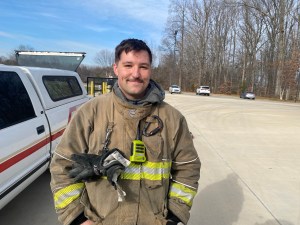
Luke Burris found inspiration to join the fire service from one of his friends at a local gym, who was an Albemarle firefighter. (Photo by Chris Miller).
Trending
Burris, who is from the Aquadale area, was one of eight recruits that comprised the third class of the City of Albemarle’s Firefighter Cadet Academy, an intensive 18-week training where cadets learn everything it takes to make it in the profession. This includes time in the classroom, combined with countless hours of physical exercise and a variety of real-world training exercises.
Five of the eight recruits, including Burris, were already employed with the Albemarle Fire Department, while the other three came from Endy Fire Department, Ridgecrest Fire Department and Badin Lake Fire Department in Montgomery County.
The training introduces many cadets to the firefighting profession and what they will need to do once they graduate and become certified firefighters.
“It’s designed so that anyone who wants to be in the fire service and can pass the physical requirements and the tests can come in,” Albemarle Public Information Officer David Fath said. “You don’t have to be a kid who’s always wanted to be a firefighter to join this program.”
But the cadets will be challenged in many ways.
After bringing up the topic of physical exercise, Burris remembers his friend from the gym telling him that very little running was required of firefighters.
Trending
“So it was a shock when we started running about 15 miles a week,” Burris said.
How The Cadet Academy Began
The cadet academy was the brainchild of Assistant Fire Chief Kenny Kendall, who helped start the program with Fire Chief T. Pierre Brewton three years ago. It made sense for the department to train recruits in-house, where instructors could work with and get to know their future colleagues, as opposed to sending them elsewhere for training.
“Why do we need to be doing that when we’ve got our own people and our own instructors?” said Kendall, who oversees the academy and used to be the chief of training. “We’ve got the capabilities of doing it right here at home, so let’s do it here.”
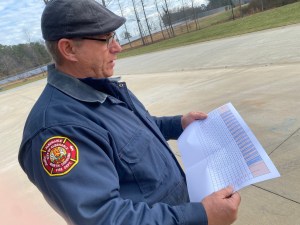
Albemarle Assistant Fire Chief Kenny Kendall helped create the Cadet Academy three years ago. (Photo by Chris Miller).
Albemarle Fire Department partners with many organizations, including Stanly Community College, which is one of the key funding sources, and Rowan-Cabarrus Community College, which lets the department utilize its Fire Training Center, to help get the program off the ground.
Burris’ group, which graduated at the end of January, represented the third class to complete basic firefighting training with the department, earning their North Carolina State Firefighters Certification and getting sworn in as certified firefighters. Twenty-six cadets have come through the academy since 2020, Kendall said, of which 14 were AFD recruits.
There has been a notable spike in interest among prospective firefighters wanting to join the department since the cadet academy got off the ground.
“I have definitely seen an increase in interest in joining the department,” Albemarle Human Resources Director Dana Chaney said.
Over the last year, since the city implemented the applicant tracking system, Chaney said she has received an average of two firefighter applications each week.
Since February 2022, there have been 83 applicants, according to data provided by Fath, with about 25% being minority candidates.
While many of the recruits, including the eight that were part of the third class, are in their 20s and 30s, Chaney said some people who have taken part in previous classes had been in their 40s.
‘Where The Rubber Meets The Road’
At the beginning of the program, cadets learn about the history of fire service in the United States, dating back to Benjamin Franklin forming the country’s first volunteer fire company in Philadelphia in 1736.
“A lot of them are really intrigued about the history because that’s what the fire service is,” Kendall said. “The fire service is all about history and tradition. That’s what we’re built on.”
Aside from the classroom portion of the academy, the recruits take part in several physically demanding and intense training modules. These trainings provide an opportunity for the students to put into action many of the topics they have learned in the classroom.
“This is where the rubber meets the road,” Kendall said.
Nowhere is that maxim more true than during the week of live fire training, which culminates in the so-called Hell Day, where cadets have to function as a team in order to rescue several dummy victims hidden throughout a two-story burning building at RCCC’s Fire Training Center.
Making their way through the space by staying pressed against the walls, the firefighters have to touch and feel their way around in search of the victims while also avoiding obstacles such as shut doors and fallen cabinets and making sure the fire hose does not get pinched.
“They have to communicate, or it’s not going to work,” Kendall said about the exercise, which typically takes teams multiple attempts to accomplish successfully. Once they set the pallets aflame, the building becomes completely dark, during which temperatures in certain areas exceed 1,000 degrees.
“We want to see them under these extreme conditions and how they react,” Kendall said. “They have to manage the scene and the situation.”
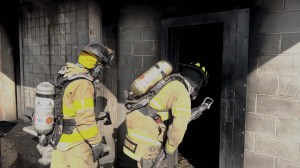
Cadets are briefed before a live fire exercise. Photo courtesy of David Fath.
The Stanly News & Press briefly joined the recruits on a Wednesday morning in mid-January, as they were beginning the first of three days of instruction at the Fire Training Center, specifically the five-story fire tower, as part of the Mayday Safety and Survival training.
The tower, which covers just over 3,400 square feet, hosts scenarios for the instruction and practice of operations such as ladder maneuvers, high-angle and rappelling rescues and confined-space escapes. Recruits transported Rescue Randy, a 150-pound dummy, down flights of stairs while also freeing themselves from an entanglement box consisting of an assortment of wires.
“It gives us the opportunity to really get to know the firefighters as they’re growing up,” said Capt. Darrin Dissler, one of the instructors during the training. “Here I get to learn and help teach them and mold them. You learn the ins and outs of each person.”

One of the recruits works his way through an entanglement box, one of several exercises during the Cadet Academy’s Mayday Safety and Survival training, which took place over a three-day span in early January. (Photo by Chris Miller).
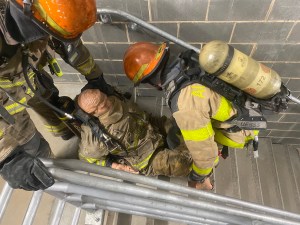
Two recruits transport a dummy, named Rescue Randy, down several flights of stairs during the Cadet Academy’s Mayday Safety and Survival training. (Photo by Chris Miller).
Forging Strong Relationships
One cadet that took part in the Mayday training was 21-year-old Matthew Collins, who has been serving Endy Volunteer Fire Department since 2017.
The training “is great because it leaves a good impression on Albemarle, so if I decide to go work for them, I already have a foot in the door,” Collins said, noting his professional training provides more opportunities for him in the future as a firefighter.
Collins did not know many of his fellow cadets at the beginning of the program, but has cultivated friendships that will last long after graduation.
“I went from knowing one of them to now spending all day every day with them since September,” Collins said. “I mean, I’ve spent more time with them than my family at home.”
And as their friendships have strengthened throughout the duration of the program — Collins refers to it as a “brotherhood” — so has their trust in each other.
“Anything I need them to do, I trust that they are going to do and vice versa,” Collins said. “If I’m stuck anywhere, I trust any one of these guys to help me.”
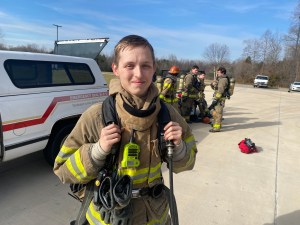
Matthew Collins has been serving Endy Volunteer Fire Department since 2017. (Photo by Chris Miller).
As the recruits learn more about the fire service and what is expected of them, they become more confident in their abilities and they improve upon areas where they may have initially struggled, such as certain elements of physical training, officials said.
Kendall, who starts getting to know the recruits on a personal level after the first few weeks of training, is especially proud of seeing the natural growth that occurs over the course of the 18 weeks. One recruit ran a 10:30-mile at the beginning of the training but by the time he graduated, Kendall said, he had shaved over two minutes off his time.
“As we move forward and I see where they were and where they are when they graduate, it’s a good feeling,” Kendall said.







